- Home
- Injections
- Laser Treatments
- Specialties
Specialtiesview all
- Other Treatments
- Before After Photos
Before After Photosview all
- Contact Us
- Doctor And Staff
- About Celibre
- Blogs
You may have heard of or read the term “frosting” when researching laser treatment for age spots, tattoos, or brown birthmarks and thought, “that sounds strange?” And while “frosting” typically conjures up visions of birthday celebrations or winter windshields, in the laser world, it’s a term that we use to describe what we see happening in the skin as it’s treated with a q-switched laser. It has nothing to do with dessert or freezing and everything to do with appearance. When we see a thin, white layer or “frost” on skin that’s just been treated with laser, we know we’re in the sweet spot—no pun intended! Let us explain a bit further.










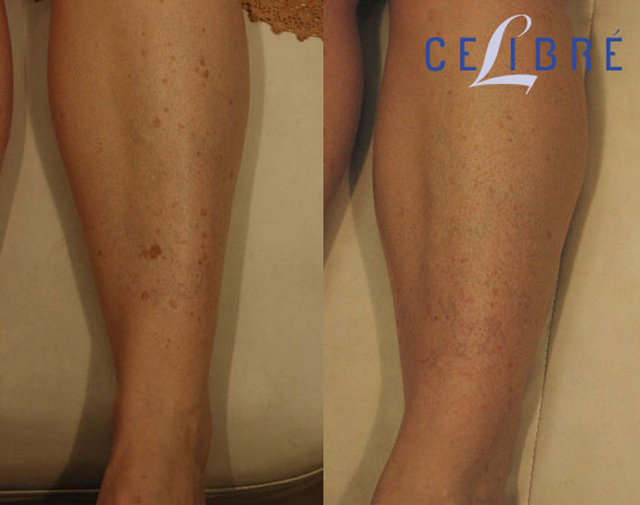

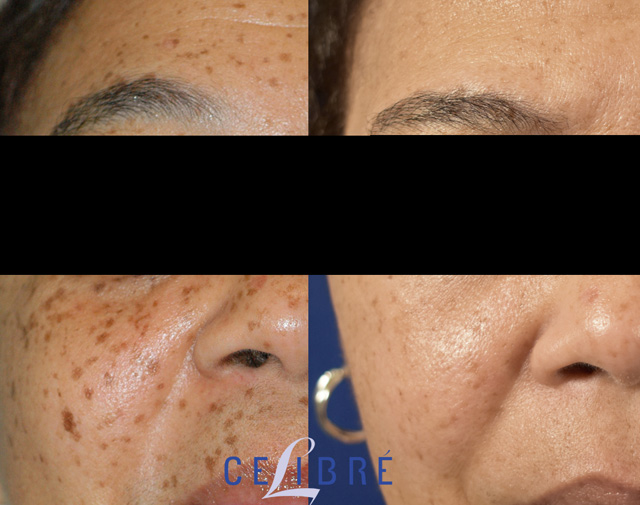











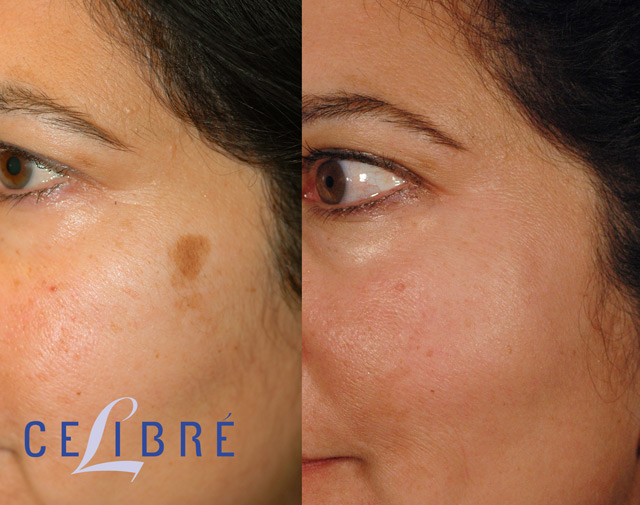

































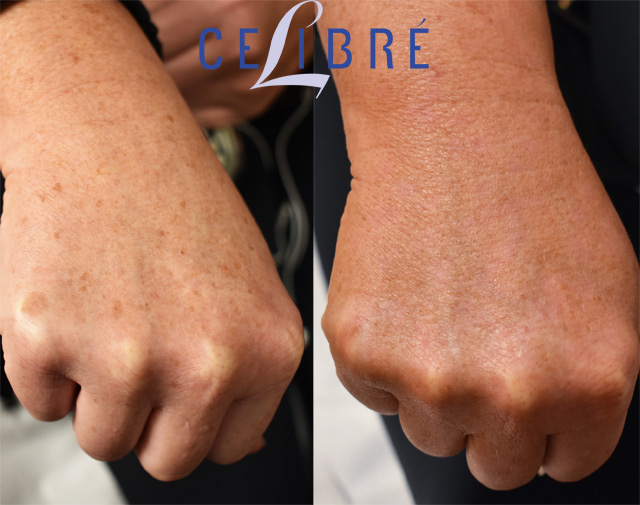



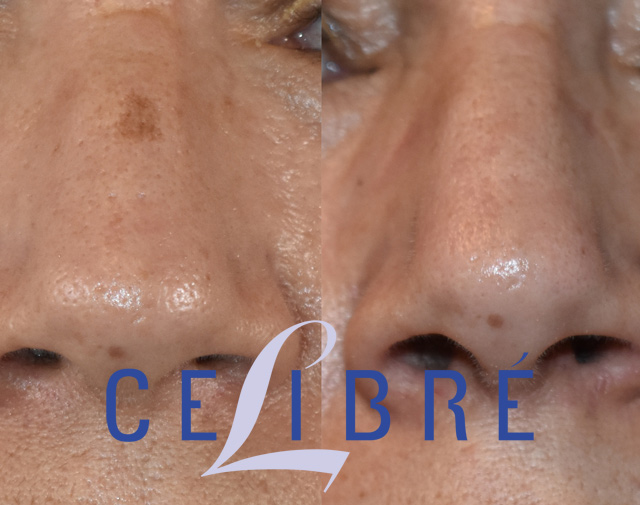













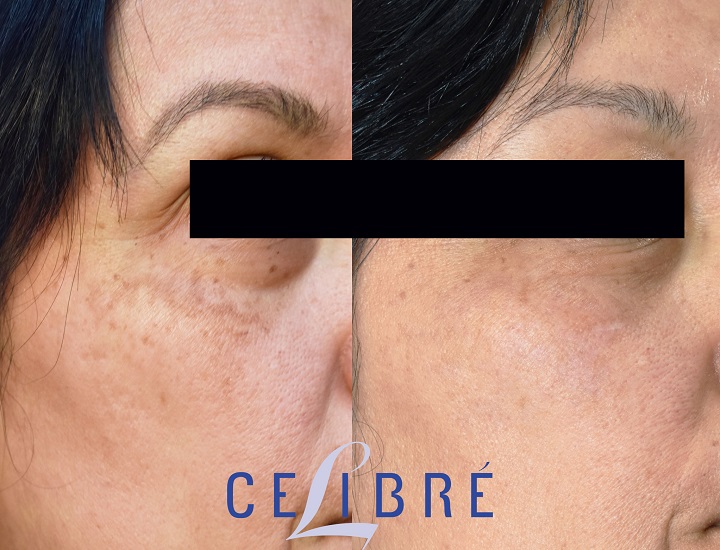









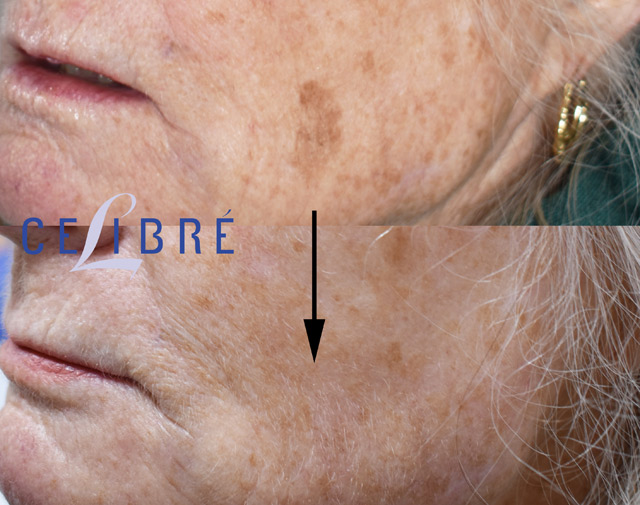

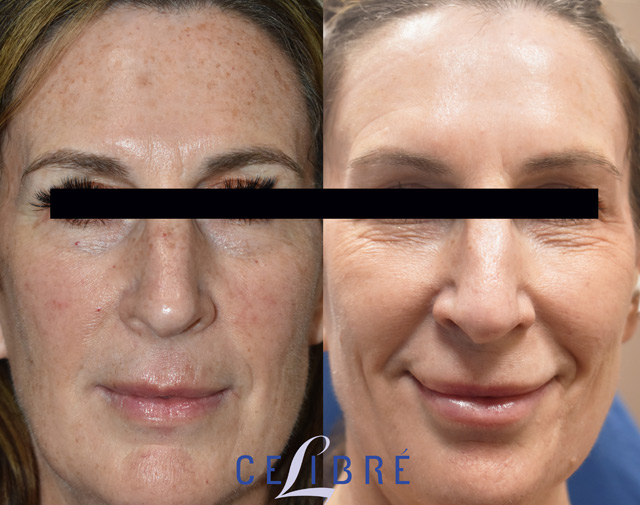













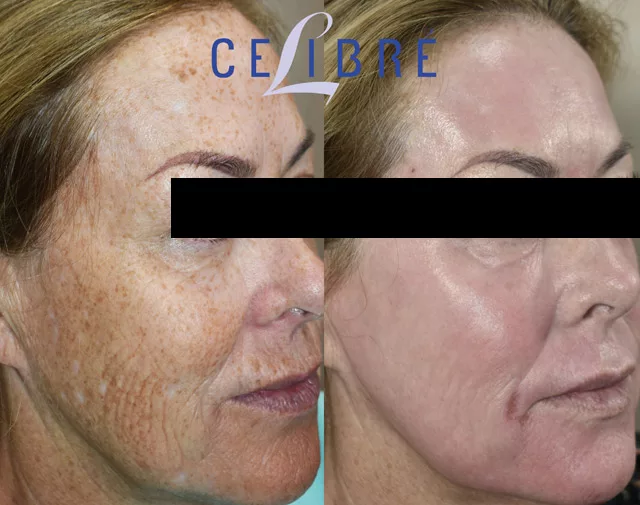





















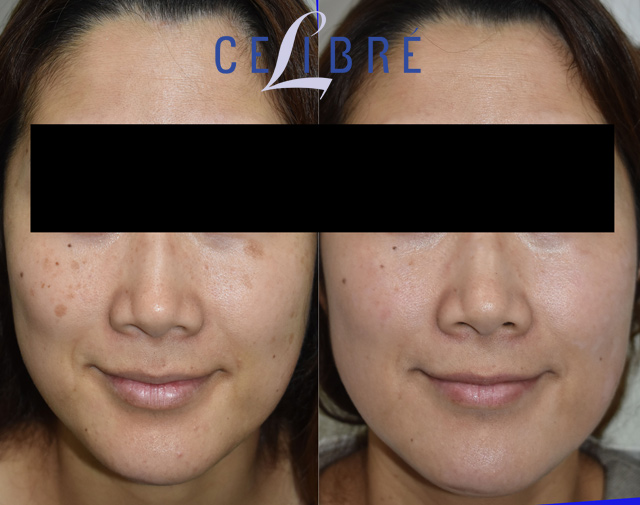









![[thumb]](https://celibre.com/wp-content/uploads/1-laser-Age-Spot-Removal-3-150x150.jpg)
![[thumb]](https://celibre.com/wp-content/uploads/2-Asian-skin-laser-age-spot-removal-2-150x150.jpg)
![[thumb]](https://celibre.com/wp-content/uploads/3-sun-damage-removal-laser-resurfacing-2-150x150.jpg)
![[thumb]](https://celibre.com/wp-content/uploads/4-Hand-spot-removal-with-lasers-1-150x150.jpg)
![[thumb]](https://celibre.com/wp-content/uploads/5-Hispanic-skin-sun-spot-removal-1-150x150.jpg)
![[thumb]](https://celibre.com/wp-content/uploads/6-leg-spot-removal-with-lasers-1-150x150.jpg)
![[thumb]](https://celibre.com/wp-content/uploads/7-African-American-freckle-removal-150x150.jpg)
![[thumb]](https://celibre.com/wp-content/uploads/8-Asian-skin-freckle-removal-150x150.jpg)
![[thumb]](https://celibre.com/wp-content/uploads/9-Hispanic-skin-age-spot-removal-150x150.jpg)
![[thumb]](https://celibre.com/wp-content/uploads/10-get-rid-of-age-spots-with-lasers-150x150.jpg)
![[thumb]](https://celibre.com/wp-content/uploads/11-liver-spot-removal-with-IPL-150x150.jpg)
![[thumb]](https://celibre.com/wp-content/uploads/12-IPL-treatment-for-sun-spots-150x150.jpg)
![[thumb]](https://celibre.com/wp-content/uploads/13-remove-liver-spots-with-lasers-150x150.jpg)
![[thumb]](https://celibre.com/wp-content/uploads/14-Asian-skin-freckle-removal-with-IPL-150x150.jpg)
![[thumb]](https://celibre.com/wp-content/uploads/15-Remove-liver-spots-with-lasers-150x150.jpg)
![[thumb]](https://celibre.com/wp-content/uploads/16-remove-my-age-spots-with-lasers-150x150.jpg)
![[thumb]](https://celibre.com/wp-content/uploads/17-laser-age-spot-removal-near-me-150x150.jpg)
![[thumb]](https://celibre.com/wp-content/uploads/18-cheek-dark-spots-removal-150x150.jpg)
![[thumb]](https://celibre.com/wp-content/uploads/19-remove-liver-spots-laser-resurfacing-150x150.jpg)
![[thumb]](https://celibre.com/wp-content/uploads/20-removing-sun-damage-with-fractional-laser-resurfacing-150x150.jpg)
![[thumb]](https://celibre.com/wp-content/uploads/21-removal-wrinkles-and-age-spots-with-lasers-150x150.jpg)
![[thumb]](https://celibre.com/wp-content/uploads/22-age-spot-wrinkles-laser-removal-150x150.jpg)
![[thumb]](https://celibre.com/wp-content/uploads/23-freckle-removal-near-me-150x150.jpg)
![[thumb]](https://celibre.com/wp-content/uploads/24-IPL-rejuvenation-near-me-150x150.jpg)
![[thumb]](https://celibre.com/wp-content/uploads/25-IPL-near-me-150x150.jpg)
![[thumb]](https://celibre.com/wp-content/uploads/26-liver-spots-before-and-after-laser-150x150.jpg)
![[thumb]](https://celibre.com/wp-content/uploads/27-bumpy-brown-spot-removal-150x150.jpg)
![[thumb]](https://celibre.com/wp-content/uploads/28-Asian-IPL-treatment-150x150.jpg)
![[thumb]](https://celibre.com/wp-content/uploads/29-brown-spots-before-and-after-laser-treatment-1-150x150.jpg)
![[thumb]](https://celibre.com/wp-content/uploads/30-age-spot-removal-hands-150x150.jpg)
![[thumb]](https://celibre.com/wp-content/uploads/Asian-Skin-Freckle-Removal-before-after-2-24-22-150x150.jpg)
![[thumb]](https://celibre.com/wp-content/uploads/Nose-Spots-before-after-2-24-22-150x150.jpg)
![[thumb]](https://celibre.com/wp-content/uploads/33-Hispanic-skin-brown-spot-removal-150x150.jpg)
![[thumb]](https://celibre.com/wp-content/uploads/34-lip-spot-removal-peutz-jegher-syndrome-1-150x150.jpg)
![[thumb]](https://celibre.com/wp-content/uploads/35-hispanic-skin-laser-age-spot-removal-150x150.jpg)
![[thumb]](https://celibre.com/wp-content/uploads/36-Remove-Liver-spots-hands-before-after-laser-150x150.jpg)
![[thumb]](https://celibre.com/wp-content/uploads/37-seborrheic-keratosis-removal-before-after-laser-150x150.jpg)
![[thumb]](https://celibre.com/wp-content/uploads/38-Asian-skin-brown-spot-removal-before-after-150x150.jpg)
![[thumb]](https://celibre.com/wp-content/uploads/39-Hispanic-skin-age-spot-removal-before-after-laser-150x150.jpg)
![[thumb]](https://celibre.com/wp-content/uploads/40-Laser-for-sun-spots-before-and-after-photos-150x150.jpg)
![[thumb]](https://celibre.com/wp-content/uploads/41-sun-damage-before-and-after-laser-and-IPL-150x150.jpg)
![[thumb]](https://celibre.com/wp-content/uploads/42-Remove-brown-lip-spots-with-laser-before-after-150x150.jpg)
![[thumb]](https://celibre.com/wp-content/uploads/43-IPL-and-lasers-for-sun-damage-removal-before-after-photos-150x150.jpg)
![[thumb]](https://celibre.com/wp-content/uploads/44-liver-spot-removal-before-after-photos-150x150.jpg)
![[thumb]](https://celibre.com/wp-content/uploads/45-age-spot-removal-with-IPL-before-after-photos-150x150.jpg)
![[thumb]](https://celibre.com/wp-content/uploads/46-hand-spots-before-after-laser-treatment-150x150.webp)
![[thumb]](https://celibre.com/wp-content/uploads/47-age-spot-removal-with-palomar-laser-before-after-150x150.webp)
![[thumb]](https://celibre.com/wp-content/uploads/48-remove-freckles-and-sun-damage-with-IPL-before-and-after-photos-1-150x150.webp)
![[thumb]](https://celibre.com/wp-content/uploads/49-Hispanic-skin-age-spot-removal-before-and-after-1-150x150.webp)
![[thumb]](https://celibre.com/wp-content/uploads/50-Liver-spots-before-and-after-laser-treatment-150x150.webp)
![[thumb]](https://celibre.com/wp-content/uploads/50-Hispanic-Skin-brown-spot-removal-before-after-laser-150x150.webp)
![[thumb]](https://celibre.com/wp-content/uploads/51-laser-resurfacing-to-remove-age-spots-and-sun-damage-150x150.webp)
![[thumb]](https://celibre.com/wp-content/uploads/52-Hispanic-skin-before-after-age-spot-removal-with-lasers-150x150.webp)
![[thumb]](https://celibre.com/wp-content/uploads/63-Hispanic-skin-laser-for-brown-spots-before-after-150x150.webp)
![[thumb]](https://celibre.com/wp-content/uploads/54-before-after-skin-tag-sun-spot-laser-removal-150x150.webp)
![[thumb]](https://celibre.com/wp-content/uploads/55-seborrheic-keratosis-removal-with-hyfrecator-150x150.jpg)
![[thumb]](https://celibre.com/wp-content/uploads/56-Hispanic-skin-freckle-removal-before-after-laser-150x150.jpg)
![[thumb]](https://celibre.com/wp-content/uploads/57-Eliminacion-de-manchas-marrones-para-pieles-hispanas-con-laser-150x150.jpg)
![[thumb]](https://celibre.com/wp-content/uploads/58-Eliminacion-de-manchas-marrones-para-pieles-hispanas-con-laser-150x150.jpg)
![[thumb]](https://celibre.com/wp-content/uploads/59-age-spot-removal-on-the-hands-before-after-one-laser-treatment-150x150.jpg)
![[thumb]](https://celibre.com/wp-content/uploads/60-Sun-damage-before-after-laser-treatment-150x150.jpg)
![[thumb]](https://celibre.com/wp-content/uploads/61-age-spot-removal-for-brown-skin-before-after-laser-150x150.jpg)
![[thumb]](https://celibre.com/wp-content/uploads/31-japanese-skin-laser-brown-spot-removal-before-after-pictures-150x150.jpg)
![[thumb]](https://celibre.com/wp-content/uploads/32-japanese-skin-laser-brown-spot-removal-before-after-pictures-150x150.jpg)
![[thumb]](https://celibre.com/wp-content/uploads/64-vietnamese-age-spot-removal-before-after-lasers-150x150.jpg)
![[thumb]](https://celibre.com/wp-content/uploads/64-age-spot-removal-japanese-skin-before-after-laser-150x150.jpg)
![[thumb]](https://celibre.com/wp-content/uploads/65-hispanic-skin-brown-spot-removal-150x150.jpg)
A q-switched laser uses a powerful beam of light energy. That delivers both heat and a sound wave to its target, physically breaking apart pigment. In the case of tattoos, age spots, or brown birthmarks, this target is melanin or pigment in the skin. As melanin is broken up, the process creates a reaction of sorts that triggers the release of gas that becomes trapped beneath the skin’s surface. This trapped gas looks like a layer of white frost, and this is how the term “frosting” came about.
The phenomenon of frosting is completely temporary. The “frost” completely disappears within several minutes after treatment. However, it’s an important marker for a laser practitioner to see because it tells us two things: we are hitting our intended target, with the right energy and speed and we don’t need to pulse or treat the lesion any further once it appears. Frosting during laser treatment is a visual sign that gives us instantaneous feedback about how effective our laser settings are and when we can stop treating a pigmented lesion.
So, what happens after frosting from a patient’s perspective? The frosted appearance quickly fades and most patients describe a slightly crusty or flaky appearance of the skin after laser treatment. This usually lasts anywhere from 4 to 7 days (for the face). The treated areas may look and act like light scabs. But what’s really happening is that the treated melanin and melanocytes are rising to the skin’s surface to be sloughed off and replaced by new, healthy skin.
This process of skin regrowth and rejuvenation is how lasers work to remove. Pigmented age spots, birthmarks, freckles, or brown, flat moles. It can take repeated treatments with the laser to completely fade or remove. These spots because the skin must regenerate slowly over a period of time.
Q-switched lasers offer a great solution to the problem of unwanted brown, pigmented spots. There are options that involve treatments that don’t produce frosting. But these tend to be a bit slower and take more treatments overtime to give the same results. Whichever treatment method you chose. We can provide you with expert care and will walk you through your treatment process step by step.


 This is my first time ever leaving a yelp review but I have to say that Kevin gave me A+ service on CO2 laser resurfacing. The results are amazing!
This is my first time ever leaving a yelp review but I have to say that Kevin gave me A+ service on CO2 laser resurfacing. The results are amazing! Love love love the services and staff at Celibre! I've referred several friends and family. Nurse Lori is a true artist and beyond knowledgeable when it comes to her craft.
Love love love the services and staff at Celibre! I've referred several friends and family. Nurse Lori is a true artist and beyond knowledgeable when it comes to her craft. Best of the Best! I've been a patient at Celibre for over 10 years now, and even after I moved hours away, I still only trust the staff here to take care of me. They're all patient, friendly, and extremely knowledgeable. They keep detailed records of all your treatments and are careful about listening so you get the results you want while still looking natural. Nurse Lori has been my main provider for so long now, and she's been so sweet that I consider her a friend. Both Kevin and Lori are excellent, so you're in good hands with whoever you choose.
Best of the Best! I've been a patient at Celibre for over 10 years now, and even after I moved hours away, I still only trust the staff here to take care of me. They're all patient, friendly, and extremely knowledgeable. They keep detailed records of all your treatments and are careful about listening so you get the results you want while still looking natural. Nurse Lori has been my main provider for so long now, and she's been so sweet that I consider her a friend. Both Kevin and Lori are excellent, so you're in good hands with whoever you choose. I have been using products from Celibre to treat my melasma for many years now. It is the only place I have found to really improve my melasma. I would be wearing so much makeup if I had never found this place. Before using their products I was trying to color correct my dark spots using colored concealers, sponging my makeup on super thick to counteract the pigment of the dark spots.
I have been using products from Celibre to treat my melasma for many years now. It is the only place I have found to really improve my melasma. I would be wearing so much makeup if I had never found this place. Before using their products I was trying to color correct my dark spots using colored concealers, sponging my makeup on super thick to counteract the pigment of the dark spots.
 Lori is Amazing. She explains things so well. She cares and listens to what your needs are. Thanks Lori as always for your amazing artistry!
Lori is Amazing. She explains things so well. She cares and listens to what your needs are. Thanks Lori as always for your amazing artistry! I needed to lighten my dark spots before my daughter's wedding along with few other cosmetic enhancement. So I started to research on medical spa...I'm asian and I needed someone who is familiar with asian skin since our skin has a different effect of pigmentation. After I talked to several places, I decided to give this place a go. I met RN. Kevin DiCerbo there...I have lots of questions and he answered with detail explanations. His answers were direct and honest and he'll tell you what works and what doesn't. And I really really appreciated that unlike other places I visited before who sold me the services which didn't work.
I needed to lighten my dark spots before my daughter's wedding along with few other cosmetic enhancement. So I started to research on medical spa...I'm asian and I needed someone who is familiar with asian skin since our skin has a different effect of pigmentation. After I talked to several places, I decided to give this place a go. I met RN. Kevin DiCerbo there...I have lots of questions and he answered with detail explanations. His answers were direct and honest and he'll tell you what works and what doesn't. And I really really appreciated that unlike other places I visited before who sold me the services which didn't work. 
 Lori is not just my skin specialist, she has become a trusted friend over the many years I have been going to see her. She is so gentle and kind when she does the botox and filler and restylane treatments. I always go home happy and feeling good about the improvements she makes on my face. I'm in my 70's and I always get compliments from people who believe I'm much younger. I honestly believe I have her to thank for that. I will go to her for the rest of my life. She is very talented and knows exactly what to do to make anyone look younger and fresher looking as well.
Lori is not just my skin specialist, she has become a trusted friend over the many years I have been going to see her. She is so gentle and kind when she does the botox and filler and restylane treatments. I always go home happy and feeling good about the improvements she makes on my face. I'm in my 70's and I always get compliments from people who believe I'm much younger. I honestly believe I have her to thank for that. I will go to her for the rest of my life. She is very talented and knows exactly what to do to make anyone look younger and fresher looking as well.
 Lori was so knowledgeable and accommodating! She suggested a non surgical brow lift and it did wonders to help my eyes look symmetrical without surgery! Going in for my next round today!!
Lori was so knowledgeable and accommodating! She suggested a non surgical brow lift and it did wonders to help my eyes look symmetrical without surgery! Going in for my next round today!!
 Thank you to all the Celibre Medical staff for always making me feel welcomed. I've been coming to this facility for over five years, and all I can say is their service is unbeatable & the treatment you will receive is unmatched. Dara, you will be missed, but I know that you will enjoy your new journey. Thanks for constantly following up with me & im sure the entire Celibre team appreciates your hard work and dedication, especially during Covid. You rock & Lori is AMAZING :). Thanks
Thank you to all the Celibre Medical staff for always making me feel welcomed. I've been coming to this facility for over five years, and all I can say is their service is unbeatable & the treatment you will receive is unmatched. Dara, you will be missed, but I know that you will enjoy your new journey. Thanks for constantly following up with me & im sure the entire Celibre team appreciates your hard work and dedication, especially during Covid. You rock & Lori is AMAZING :). Thanks
 I was pleased about my first visitation. Kevin, the director was very professional, he explained and answered all my concerns, he suggested the phase in detail of each step, and also I was very comfortable with the staff assistant, she was very nice.
I was pleased about my first visitation. Kevin, the director was very professional, he explained and answered all my concerns, he suggested the phase in detail of each step, and also I was very comfortable with the staff assistant, she was very nice. I have been going to Lori at Celibre for years. I consider her an artist in her approach to fillers, botox and lasers. Her approach is to refresh, brighten and address any areas of concern. I prefer a more natural enhancement which is always the result I get.
I have been going to Lori at Celibre for years. I consider her an artist in her approach to fillers, botox and lasers. Her approach is to refresh, brighten and address any areas of concern. I prefer a more natural enhancement which is always the result I get. For as long as I can remember my Dad has been the sunshine of my life. There was never anything too large or too small that this man wouldn't make possible for his daughter. (Colgate smile* waves*) So naturally when I started looking into preventative aging treatment I instantly thought of my father who has always looked years younger then his true age. Look there is no escaping... We are all going to get older, but there is so many treatments that can and will help the process without turning your face into a CAT. Lol
For as long as I can remember my Dad has been the sunshine of my life. There was never anything too large or too small that this man wouldn't make possible for his daughter. (Colgate smile* waves*) So naturally when I started looking into preventative aging treatment I instantly thought of my father who has always looked years younger then his true age. Look there is no escaping... We are all going to get older, but there is so many treatments that can and will help the process without turning your face into a CAT. Lol 
 Customer service- clarifying conversations- the desired results! These are some of the proficiencies you'll encounter with these skilled professionals. They helped my skin and heart.
Customer service- clarifying conversations- the desired results! These are some of the proficiencies you'll encounter with these skilled professionals. They helped my skin and heart.
 Lori is absolutely remarkable. She works miracles on my look. When I leave I look 10 yrs younger and it's a natural look! Roxanne
Lori is absolutely remarkable. She works miracles on my look. When I leave I look 10 yrs younger and it's a natural look! Roxanne
 I've been going to Celibre and getting treatments from Lori for over 10 years now. I've had dysport, fillers, and now laser treatments. Obviously, I'm extremely happy with the results and can honestly say I love everything she's done for me. I'm in my 40's now but don't look it at all. I look like I've aged backwards. I'm glad I started when I did because it really is preventative of future aging.
I've been going to Celibre and getting treatments from Lori for over 10 years now. I've had dysport, fillers, and now laser treatments. Obviously, I'm extremely happy with the results and can honestly say I love everything she's done for me. I'm in my 40's now but don't look it at all. I look like I've aged backwards. I'm glad I started when I did because it really is preventative of future aging. I just recently had the profractional laser done at Celibre in December. It has literally shaved 10 years off of my appearance. My skin is brighter, the texture is so much better, my pores are smaller, the sun damage is almost non-existent, my melasma got better and I was scared that it would get worse because that can happen from the laser. And Celibre told me that it was a possibility, but luckily it did not. It did require some time off but again it wasn't anything that wasn't explained to me by Celibre. They answered all my questions and went over everything in detail. That's another thing that I love about Celibre. You never feel rushed or like you can't have any and all of your questions asked. They always make you feel like the star of the show and I appreciate that. Celibre is the BEST place to go to for fillers, botox, or lasers. I get all of my procedures done there and wouldn't go anywhere else. I even commute from Orange County because they are that good! Celibre keeps your budget and your goals both in mind when helping you pick your procedures. I love Kevin, and Lori, and all of the girls in the front desk. They are not snooty whatsoever and again always make you feel special. I CAN'T BE MORE CLEAR ABOUT THIS, IF YOU GET BOTOX, LASERS, OR FILLERS GO TO CELIBRE!!!!! THEY SET THE BAR! THEY ARE THE BAR! THEY ARE THE BEST!!!!!!!!!!!!!!! YOU WILL NOT BE SORRY I PROMISE!!!!!!!!! I LOVE CELIBRE!
I just recently had the profractional laser done at Celibre in December. It has literally shaved 10 years off of my appearance. My skin is brighter, the texture is so much better, my pores are smaller, the sun damage is almost non-existent, my melasma got better and I was scared that it would get worse because that can happen from the laser. And Celibre told me that it was a possibility, but luckily it did not. It did require some time off but again it wasn't anything that wasn't explained to me by Celibre. They answered all my questions and went over everything in detail. That's another thing that I love about Celibre. You never feel rushed or like you can't have any and all of your questions asked. They always make you feel like the star of the show and I appreciate that. Celibre is the BEST place to go to for fillers, botox, or lasers. I get all of my procedures done there and wouldn't go anywhere else. I even commute from Orange County because they are that good! Celibre keeps your budget and your goals both in mind when helping you pick your procedures. I love Kevin, and Lori, and all of the girls in the front desk. They are not snooty whatsoever and again always make you feel special. I CAN'T BE MORE CLEAR ABOUT THIS, IF YOU GET BOTOX, LASERS, OR FILLERS GO TO CELIBRE!!!!! THEY SET THE BAR! THEY ARE THE BAR! THEY ARE THE BEST!!!!!!!!!!!!!!! YOU WILL NOT BE SORRY I PROMISE!!!!!!!!! I LOVE CELIBRE! I highly recommend Lori for any skin concerns or treatments that Celibre offers! She took the time to listen to my concerns and gave me honest feedback. I came in for hyperpigmentation that I've had for years and I couldn't find a place that could help me solve the issue. Lori provided a treatment that has pretty much gotten rid of my hyperpigmentation after the first treatment and I couldn't be more excited! I'll definitely be returning for future treatments! Thank you Lori!
I highly recommend Lori for any skin concerns or treatments that Celibre offers! She took the time to listen to my concerns and gave me honest feedback. I came in for hyperpigmentation that I've had for years and I couldn't find a place that could help me solve the issue. Lori provided a treatment that has pretty much gotten rid of my hyperpigmentation after the first treatment and I couldn't be more excited! I'll definitely be returning for future treatments! Thank you Lori! I normally do not write reviews but I have to say that Celibre is the best. The office staff is always welcoming. Lori Haney is an artist. I have been going to her for probably at least 6 years. She is honest and I trust her to tell me her opinion about what procedures are best for me and understands that I want a natural, fresher look. I always walk out feeling better than when I walked in. Kevin is equally honest and a true professional.
I normally do not write reviews but I have to say that Celibre is the best. The office staff is always welcoming. Lori Haney is an artist. I have been going to her for probably at least 6 years. She is honest and I trust her to tell me her opinion about what procedures are best for me and understands that I want a natural, fresher look. I always walk out feeling better than when I walked in. Kevin is equally honest and a true professional.  I am so impressed with the service and quality from Celibre. I drive an hour for injections from Lori Haney. She is the best and is highly knowledgeable. I'm very happy with my results!
I am so impressed with the service and quality from Celibre. I drive an hour for injections from Lori Haney. She is the best and is highly knowledgeable. I'm very happy with my results! The staff here are very welcoming and informative! I'm the type to ask to ask questions on anything new I am trying for the first time and I have to say that every question I asked was answered with a honest and well informed answer which definitely made my decision to get dysport for the first time that much easier. Kevin was very informative, he listened to my concerns and gave great feedback and did a excellent job on the areas that I got dysport.
The staff here are very welcoming and informative! I'm the type to ask to ask questions on anything new I am trying for the first time and I have to say that every question I asked was answered with a honest and well informed answer which definitely made my decision to get dysport for the first time that much easier. Kevin was very informative, he listened to my concerns and gave great feedback and did a excellent job on the areas that I got dysport.
 Although I'm new fairly new to Celibre, I've been very pleased with the service so far. Honesty is very important to me and Kevin DiCerbo has made sure to keep it 100% about what I can expect based on the procedure that I'm having. He takes the time to explain the process and why he recommends one approach versus another. Unlike other places, it makes me feel like he's not just trying to take my money. Kevin actually cares about his clients. Most recently, my teenage son was struggling with an insecurity and after taking him to Kevin he feels much more confident and that makes me happy. If you haven't done so already, please give Celibre a try! You will not be disappointed.
Although I'm new fairly new to Celibre, I've been very pleased with the service so far. Honesty is very important to me and Kevin DiCerbo has made sure to keep it 100% about what I can expect based on the procedure that I'm having. He takes the time to explain the process and why he recommends one approach versus another. Unlike other places, it makes me feel like he's not just trying to take my money. Kevin actually cares about his clients. Most recently, my teenage son was struggling with an insecurity and after taking him to Kevin he feels much more confident and that makes me happy. If you haven't done so already, please give Celibre a try! You will not be disappointed.
 I loooove how the Celibre's staff is so knowledgeable in facial construction, symmetry & features and don't focus just on huge fake duck lips and SPOC eyebrows like everyone else in LA (unless this is what you want I'm sure they can cater to you also ) !! I always look so refreshed and natural , not like my face is frozen or aerodynamic (my way of describing when fillers and Botox goes bad, especially in the eyebrow area) I'm in my 40's and I looked for a place that knew what they were doing not something randomly off Instagram or Groupon !!! But I must say, Nurse Lori won me with all her educational and Informative instagram posts !!!
I loooove how the Celibre's staff is so knowledgeable in facial construction, symmetry & features and don't focus just on huge fake duck lips and SPOC eyebrows like everyone else in LA (unless this is what you want I'm sure they can cater to you also ) !! I always look so refreshed and natural , not like my face is frozen or aerodynamic (my way of describing when fillers and Botox goes bad, especially in the eyebrow area) I'm in my 40's and I looked for a place that knew what they were doing not something randomly off Instagram or Groupon !!! But I must say, Nurse Lori won me with all her educational and Informative instagram posts !!!
 Called for a consultation and spoke with Kevin I told him I was interested in my smile lines so he booked me a consultation for the next day at 9am, I went in I was greeted by name by the receptionist she had me feel out a few forms and took me right back, they took before pics I spoke with Kevin as soon as I got there he answered all my questions, showed me examples the whole nine. He even recommended medication for my acne scars instead of just doing another treatment I didn't need so far I am happy with them and will be returning. They also accept care credit and Alpheon credit to free interest for 6 months
Called for a consultation and spoke with Kevin I told him I was interested in my smile lines so he booked me a consultation for the next day at 9am, I went in I was greeted by name by the receptionist she had me feel out a few forms and took me right back, they took before pics I spoke with Kevin as soon as I got there he answered all my questions, showed me examples the whole nine. He even recommended medication for my acne scars instead of just doing another treatment I didn't need so far I am happy with them and will be returning. They also accept care credit and Alpheon credit to free interest for 6 months
 I cannot say enough great things about this place. The front desk staff are super personable, nice and welcoming. Kevin DiCerbo has been helping me since I moved to South Bay since about a year ago.
I cannot say enough great things about this place. The front desk staff are super personable, nice and welcoming. Kevin DiCerbo has been helping me since I moved to South Bay since about a year ago. I was referred to Celibre by a friend and was not disappointed. The office is clean, open and had great music playing. Front office staff was super welcoming. Lori was knowledgeable, sweet and answered all my questions before I had my treatment. I felt like she had my best interest and for a first time customer felt like I've been seeing her for years. I will be going back and referring Celibre and Lori to all my friends and family!!
I was referred to Celibre by a friend and was not disappointed. The office is clean, open and had great music playing. Front office staff was super welcoming. Lori was knowledgeable, sweet and answered all my questions before I had my treatment. I felt like she had my best interest and for a first time customer felt like I've been seeing her for years. I will be going back and referring Celibre and Lori to all my friends and family!!
 Awesome Staff and love the laser hair removable service... best thing I've done so far!!!
Awesome Staff and love the laser hair removable service... best thing I've done so far!!!
 Omg !!! What to say... I have a birthmark on my face and tried my whole life to get rid of it. No doctor could until Kevin !! I first called to ask some questions, he was so clear about everything, about what to expect, when the results would appear etc...
Omg !!! What to say... I have a birthmark on my face and tried my whole life to get rid of it. No doctor could until Kevin !! I first called to ask some questions, he was so clear about everything, about what to expect, when the results would appear etc...  What an amazing experience!!! Not only did I love my results (which can we be honest, that's why we are all here) but Lori was so full of knowledge, walking me through each step! Don't have one negative about my experience.
What an amazing experience!!! Not only did I love my results (which can we be honest, that's why we are all here) but Lori was so full of knowledge, walking me through each step! Don't have one negative about my experience. Very professional and patient! They will educate you, and answer all of your questions.
Very professional and patient! They will educate you, and answer all of your questions. I had gone to Celibre 10 years ago and had a great experience- so I decided to go back and have Lori (who I had before) do my injecting of Restlylane and Dysport. She is INCREDIBLE!! She is kind, gentle (important!) caring, explains everything beforehand...all around a beautiful person who loves to help people and loves her career! For having needles stuck in my face--it was a GREAT experience! I had to come back for a touch up and she took care of it for no charge! If you are nervous- don't be, you'll be fine with Lori!
I had gone to Celibre 10 years ago and had a great experience- so I decided to go back and have Lori (who I had before) do my injecting of Restlylane and Dysport. She is INCREDIBLE!! She is kind, gentle (important!) caring, explains everything beforehand...all around a beautiful person who loves to help people and loves her career! For having needles stuck in my face--it was a GREAT experience! I had to come back for a touch up and she took care of it for no charge! If you are nervous- don't be, you'll be fine with Lori!
 I had gone to Celibre 10 years ago and had a great experience- so I decided to go back and have Lori (who I had before) do my injecting of Restlylane and Dysport. She is INCREDIBLE!! She is kind, gentle (important!) caring, explains everything beforehand...all around a beautiful person who loves to help people and loves her career! For having needles stuck in my face--it was a GREAT experience! I had to come back for a touch up and she took care of it for no charge! If you are nervous- don't be, you'll be fine with Lori!
I had gone to Celibre 10 years ago and had a great experience- so I decided to go back and have Lori (who I had before) do my injecting of Restlylane and Dysport. She is INCREDIBLE!! She is kind, gentle (important!) caring, explains everything beforehand...all around a beautiful person who loves to help people and loves her career! For having needles stuck in my face--it was a GREAT experience! I had to come back for a touch up and she took care of it for no charge! If you are nervous- don't be, you'll be fine with Lori!
 Very clean, kind friendly staff, provided me with a lot of preliminary information. I had a lot of questions and Kevin took his time in answering them all.
Very clean, kind friendly staff, provided me with a lot of preliminary information. I had a lot of questions and Kevin took his time in answering them all. Lori is an angel from heaven. I mean it!!
Lori is an angel from heaven. I mean it!!  Lori is an angel from heaven. I mean it!!
Lori is an angel from heaven. I mean it!!  I had a great experience here. The staff is very friendly and welcoming. Nurse Kevin used Restylane to fill under my eyes to help reduce the bags and fat pads that made me look tired. Kevin used a little over 1 vial of Restylane between both of my eyes and made sure I was happy with the final result before I left.
I had a great experience here. The staff is very friendly and welcoming. Nurse Kevin used Restylane to fill under my eyes to help reduce the bags and fat pads that made me look tired. Kevin used a little over 1 vial of Restylane between both of my eyes and made sure I was happy with the final result before I left. 
 Stars to the moon for this wonderful place. Talk about an educated and highly skilled staff. I was beyond satisfied with my experience here. Came after after diligent research on a laser they offer . Lori went above and beyond to educate and inform in a way no other medical professional has. She has a lovely bedside manner and made my experience as comfortable as possible. Rest assured you are in good hands if booking an appt. can't wait to see the final results.
Stars to the moon for this wonderful place. Talk about an educated and highly skilled staff. I was beyond satisfied with my experience here. Came after after diligent research on a laser they offer . Lori went above and beyond to educate and inform in a way no other medical professional has. She has a lovely bedside manner and made my experience as comfortable as possible. Rest assured you are in good hands if booking an appt. can't wait to see the final results.
 I love this place and the people that work here. Lori is the BEST! She takes the time to explain the benefits and risks of all of the lasers and injectables, helping me find a plan within my budget...the most bang for my buck. Not every procedure has had the "wow" desired effect I wanted, but they warned me that it may not be as effective as I hoped. They have always gone above and beyond to make things right. We all go because we want to look and feel better & there's no one I trust more than Lori to help keep me looking my best.
I love this place and the people that work here. Lori is the BEST! She takes the time to explain the benefits and risks of all of the lasers and injectables, helping me find a plan within my budget...the most bang for my buck. Not every procedure has had the "wow" desired effect I wanted, but they warned me that it may not be as effective as I hoped. They have always gone above and beyond to make things right. We all go because we want to look and feel better & there's no one I trust more than Lori to help keep me looking my best.
 I called to ask for information. Very pleasant experience, not put in hold, very helpful and not pushy about making an appt. Got all of my questions answered
I called to ask for information. Very pleasant experience, not put in hold, very helpful and not pushy about making an appt. Got all of my questions answered
 The wait is finally over! I've been searching for a great place to help me take care of my skin and fight ageing and all that good stuff. This is it and it's local (no more schlepping to Beverly Hills!).
The wait is finally over! I've been searching for a great place to help me take care of my skin and fight ageing and all that good stuff. This is it and it's local (no more schlepping to Beverly Hills!).
 I am blown away. The Office is lovely, the receptionist super nice, even the owners is hot, but really it's Lori. WOW. She knows her stuff. I told her all my concerns and she was able to do ONE procedure that fixed everything that was bothering me. This is SKILL. She is excellent at looking at your "whole face" and really able to address your needs affectively. For example, I thought I needed voluma in my face and thanks to Lori and her knowledge I got restalyn silk underneath my eyes and fixed my problem. Plus it was way cheaper than the treatment I thought I needed! I literally could not be happier! I have been doing fillers for years and I am saying will never go to anyone else again. Doesn't get much better. Thank you Lori!!!!
I am blown away. The Office is lovely, the receptionist super nice, even the owners is hot, but really it's Lori. WOW. She knows her stuff. I told her all my concerns and she was able to do ONE procedure that fixed everything that was bothering me. This is SKILL. She is excellent at looking at your "whole face" and really able to address your needs affectively. For example, I thought I needed voluma in my face and thanks to Lori and her knowledge I got restalyn silk underneath my eyes and fixed my problem. Plus it was way cheaper than the treatment I thought I needed! I literally could not be happier! I have been doing fillers for years and I am saying will never go to anyone else again. Doesn't get much better. Thank you Lori!!!!
 I had an amazing experience there. After going back and forth with one of the owners, Kevin, to make sure they could remove botched permanent eyeliner, I booked an appointment. I went and saw Lori, who was very professional and sweet at the same time.
I had an amazing experience there. After going back and forth with one of the owners, Kevin, to make sure they could remove botched permanent eyeliner, I booked an appointment. I went and saw Lori, who was very professional and sweet at the same time.
